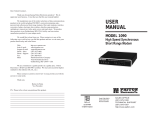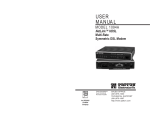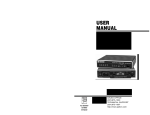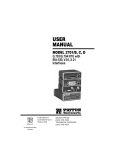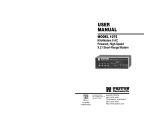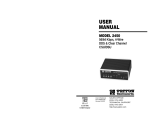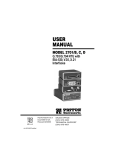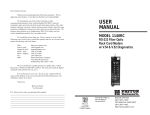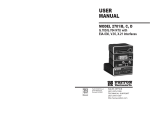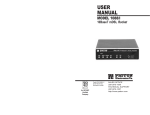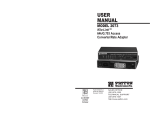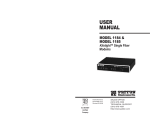Download Patton electronic 1094 User's Manual
Transcript
USER MANUAL MODEL 1094 KiloModem-768 High Speed Baseband Modem TM Part# 07M1094-C Doc# 032031UC R evised 04/13/99 CERTIFIED An ISO-9001 Certified Company SALES OFFICE (301) 975-1000 TECHNICAL SUPPORT (301) 975-1007 http://www.patton.com 1.0 WARRANTY INFORMATION 1.3 SERVICE Patton Electronics warrants all Model 1094 components to be free from defects, and will—at our option—repair or replace the product should it fail within one year from the first date of shipment. This warranty is limited to defects in workmanship or materials, and does not cover customer damage, abuse or unauthorized modification. If this product fails or does not perform as warranted, your sole recourse shall be repair or replacement as described above. Under no condition shall Patton Electronics be liable for any damages incurred by the use of this product. These damages include, but are not limited to, the following: lost profits, lost savings and incidental or consequential damages arising from the use of or inability to use this product. Patton Electronics specifically disclaims all other warranties, expressed or implied, and the installation or use of this product shall be deemed an acceptance of these terms by the user. 1.1 RADIO AND TV INTERFERENCE The Model 1094 generates and uses radio frequency energy, and if not installed and used properly—that is, in strict accordance with the manufacturer's instructions—may cause interference to radio and television reception. The Model 1094 has been tested and found to comply with the limits for a Class A computing device in accordance with the specifications in Subpart J of Part 15 of FCC rules, which are designed to provide reasonable protection from such interference in a commercial installation. However, there is no guarantee that interference will not occur in a particular installation. If the Model 1094 does cause interference to radio or television reception, which can be determined by removing power from the unit, the user is encouraged to try to correct the interference by one or more of the following measures: moving the computing equipment away from the receiver, re-orienting the receiving antenna and/or plugging the receiving equipment into a different AC outlet (such that the computing equipment and receiver are on different branches). All warranty and non-warranty repairs must be returned freight prepaid and insured to Patton Electronics. All returns must have a Return Materials Authorization number on the outside of the shipping container. This number may be obtained from Patton Electronics Technical Service at: TEL: (301) 975-1007 Email: [email protected]. www: http://www.patton.com NOTE: Packages received without an RMA number will not be accepted. Patton Electronics’ technical staff is also available to answer any questions that might arise concerning the installation or use of your Model 1094. Technical Support hours: 8AM to 5PM EST, Monday through Friday. 1.2 CE NOTICE The CE symbol on your Patton Electronics equipment indicates that it is in compliance with the Electromagnetic Compatibility (EMC) directive and the Low Voltage Directive (LVD) of the Union European (EU). A Certificate of Compliance is available by contacting Technical Support. 1 2 2.0 GENERAL INFORMATION 3.0 CONFIGURATION Thank you for your purchase of this Patton Electronics product. This product has been thoroughly inspected and tested and is warranted for One Year parts and labor. If any questions or problems arise during installation or use of this product, please do not hesitate to contact Patton Electronics Technical Support at (301) 975-1007. The Model 1094 is equipped with one set of eight DIP switches, and one set of four DIP switches (all externally accessible). These DIP switches allow configuration of clock source, carrier control, loopback tests and data rate. This section describes switch locations and explains all possible configurations. 2.1 FEATURES 3.1 EXTERNAL DIP SWITCH SETTINGS • Synchronous data rates of 384 and 768 kbps • Frequency Shift Key (FSK) modulation • Full or half duplex operation over two twisted pair (4-wire) • Point-to-point distances up to 4.9 miles (19 AWG @ 384 kbps) The Model 1094’s DIP switches are located on the underside of the unit (see Figure 1, below). Figure 2 shows the orientation of the switch set. All possible settings for the Model 1094’s DIP switches are presented in the summary table and descriptions on the following pages. • V.54 compliant local and remote loopback tests (DTE or front panel activated) REAR • V.52 compliant Bit Error Rate (BER) test pattern generator • Replaceable DTE-DCE QuickConnect™ interface modules S1 S2 • Internal, external or receive recovered clocking options • Automatic equalization 1 2 3 4 5 6 7 8 1 2 3 4 ON ON • Made in the U.S.A. 2.2 DESCRIPTION The Patton Model 1094 Synchronous Short Range Modem is designed for point-to-point, high speed communication over 4-wires (two twisted pair). Supporting switch-selectable data rates of 384 and 768 kbps, the Model 1094 is perfect for connecting two bridge/routers, or for similar campus applications at distances up to 4.9 miles (7.9 km). The Model 1094 incorporates built-in V.54 loopback tests, a V.52 BERT pattern generator and seven front panel LED indicators. Data integrity is enhanced by automatic equalization and gain control. The Model 1094 also incorporates transformer isolation and surge protection to guard data and connected equipment against the hazards of ground loops and transient surges. Clocking options include internal, external and receive recover clock. The Model 1094 features replaceable DCE-DTE QuickConnect™ interface modules. Several different modules are available (call Patton Sales for details). Line connection is made by RJ-45 jack. Internal AC power supply options include 120 or 230VAC (switchable), 85-256VAC (universal) or 48VDC. FRONT Figure 1. Underside of Model 1094 Showing External DIP Switch Locations S2 S1 ON ON ON 1 2 3 4 5 6 7 8 1 2 3 4 Figure 2. Close Up of Configuration Switches 3 4 OFF Switch S1-3: RTS/CTS Delay S1 SUMMARY TABLE Position Function Factory Default S1-1 Clock Source* On S1-2 Clock Source* On S1-3 RTS/CTS Delay On Short Delay S1-4 LDL Off Disabled S1-5 Carrier Control Off Constant S1-6 DTE Control of RDL Off Disabled S1-7 DTE Control of LAL Off Disabled S1-8 V.54 Enable/Disable Off Enabled } Internal *See Note in SWITCH SET S1 (Below) for X.21 Clock Sources 3.1.1 Switch Set S1 The configuration switches on S1 set clock source, RTS/CTS delay, carrier control, loopback tests. The default settings are summarized in the table above. Switches S1-1 and S1-2: Clock Source Switches S1-1 and S1-2 are set in combination to determine the source of timing for the Model 1094. Switch S1-3 is used in combination to determine the amount of delay between the time RTS is activated and the 1094 activates the CTS. S1-3 On Off Function Short delay (1-4 ms) Long delay (8-20 ms) Switch S1-4: LDL Control Switch S1-4 determines whether the frontt panel switch can activate a Local Digital Loopback (LDL) diagnostic test. S1-4 On Off Function LDL Control Enabled LDL Control Disabled Switch S1-5: Carrier Control The setting for switch S1-5 determines whether the carrier is “constantly on” or “controlled by RTS”. This setting allows for operation in switched carrier or hardware handshaking applications. S1-5 On Off Setting Controlled by RTS Constantly ON Switch S1-6: DTE Control of RDL S1-1 On On Off Off S1-2 On Off On Off Setting Internal Receive recover External transmit clock Not a valid setting NOTE: When an X.21 QuickConnect™ module is installed in one or both base units, one base unit must be configured for receive recover clock source. The particular application will dictate which unit must be configured for receive recover clock source. The setting for switch S1-6 determines whether DTE control of remote-digital loopback test is enabled or disabled. If DTE control is disabled, the RDL test can only be initiated by the front panel switch. S1-6 On Off Switch S1-7: DTE Control of LAL The setting for switch S1-7 determines whether DTE control of local analog loopback test is enabled or disabled. If DTE control is disabled, the LAL test can only be initiated by the front panel switch. S1-7 On Off 5 Setting DTE control enabled DTE control disabled Setting DTE control enabled DTE control disabled 6 4.0 INSTALLATION Switch S1-8: V.54 Enable / Disable The setting for switch S1-8 determines whether the Model 1094 will respond when it receives the V.54 sequence. If you suspect the Model 1094 may be getting tricked into the loopback test by false detection of user data, you can try setting this to “Disable.” S1-8 On Off 4.1 CONNECTION TO THE TWISTED PAIR INTERFACE Setting Disabled Enabled The Model 1094 supports communication between two terminal devices at distances to 4.9 miles (7.9 km) and data rates to 768 kbps. There are two essential requirements for installing the Model 1094: 3.1.2 Switch Set S2 The settings for DIP switches S2-1 through S2-4 determine the synchronous data rate of the Model 1094. All possible settings (including the default) are shown below: S2-1 Off On S2-2 On Off Once the Model 1094 is properly configured, it is ready to connect to the twisted pair interface, to the serial port, and to the power source. This section tells you how to make these connections. S2-3 On Off S2-4 On Off Setting 384 kbps 768 kbps (default) 1. These units work in pairs. Therefore, you must have one Model 1094 (or a compatible model) at each end of a two twisted pair interface. 2. To function properly, the Model 1094 needs two twisted pairs of metallic wire. These twisted pairs must be unconditioned, dry, metallic wire, between 19 and 26 AWG (.4 mm and .9 mm, inversely) (the higher AWG gauges may limit distance somewhat). Standard dial-equalization equipment, or standard, flat modular telephone type cable, are not acceptable. 4.1.1 TWISTED PAIR CONNECTION USING RJ-45 The Model 1094 uses a modular RJ-45 jack for twisted pair line connection. The signal/pin relationships are shown below: RJ-45 SIGNAL 1 ..........................XMT+ 2 ..........................XMT3 ..........................N/C 4 ..........................GND* 5 ..........................GND* 6 ..........................N/C 7 ..........................RCV+ 8 ..........................RCV- 1 2 3 4 5 6 7 8 *Connection to ground is optional 7 8 When connecting two Model 1094’s, it is necessary to use a crossover cable. The diagram below shows how a crossover cable should be constructed. RJ-45 Cable (4-Wire) SIGNAL PIN# PIN# XMT+ XMTGND* GND* RCV+ RCV- 1-----------------------8 2-----------------------7 4-----------------------5 5-----------------------4 7-----------------------2 8-----------------------1 4.2.1 CHANGING QUICKCONNECT™ MODULES When you purchase a particular version of the Model 1094, it should be shipped to you with the appropriate QuickConnect™ Module already installed. If you need to install a different QuickConnect™ Module, follow these steps. SIGNAL Removing the Existing QuickConnect™ Module RCVRCV+ GND* GND* XMTXMT+ *Connection to ground is optional 1. Turn the power switch off. Leave the power cord plugged into a grounded outlet to keep the unit grounded. 2. Loosen the two thumbscrews on the module by turning them counterclockwise. 3. Grasp the two thumbscrews and gently pull the module from the unit. Apply equal force to the thumbscrews to keep the module straight during the removal process. 4.2 CONNECTION TO THE SERIAL PORT Installing the New QuickConnect™ Module The serial port interface on the Model 1094 uses interchangeable Quick Connect Modules. Each Quick Connect Module has a 50-pin card edge connector on one side and a serial port interface on the other. Figure 3 (below) shows how a Quick Connect™ Module plugs into the back of the Model 1094. 1. Make sure the power switch is off. Leave the power cord plugged into a grounded outlet to keep the unit grounded. 2. Hold the module with the faceplate toward you and align the module with the guide slots in the rear panel of the Model 1094. 3. While keeping the module’s faceplate parallel with the Model 1094 rear panel, slide the module straight in–so that the card edge contacts line up with the socket inside the chassis. e Lin ort eP ac erf Int N 1O FF 0O Figure 3. Installation of Model 1094 Plug-in Serial Interface Module NOTE: The card edge connector should meet the socket when it is almost all the way into the chassis. If you encounter a lot of resistance, remove the module and repeat Steps 2 and 3. 4. With the card edge contacts aligned with the socket, firmly seat the module by using your thumbs to apply pressure directly to the right and left edges of the module faceplate. Applying moderate and even pressure should be sufficient to seat the module. You should hear it snap into place. 5. To secure the module in place, push the thumbscrews into the chassis and turn the screws clockwise to tighten. 9 10 4.2.2 CONNECTION TO A “DTE” DEVICE The serial port on most QuickConnect™ interface modules (all except the X.21 module) is hard-wired as a DCE. Therefore these modules “want” to plug into a DTE such as a terminal, PC or host. When making the connection to your DTE device, use a straight through cable of the shortest possible length—we recommend 6 feet or less. When purchasing or constructing an interface cable, please refer to the pin diagrams in Appendix D as a guide. 4.2.3 CONNECTION TO A “DCE” DEVICE If the Model 1094’s QuickConnect™ interface module is hardwired as a DCE (all except the X.21 module), you must use a null modem cable when connecting to a printer, modem, multiplexer or other DCE device. This cable should be of the shortest possible length—we recommend 6 feet or less. When purchasing or constructing a null modem interface cable, use the pin diagrams in Appendix D as a guide. Note: Pin-out requirements for null modem applications vary widely between manufacturers. If you have any questions about a specific application, contact Patton Technical Support: TEL: (301) 975-1007 Email: [email protected]. www: http://www.patton.com 4.2.4 RECONFIGURING THE X.21 QUICKCONNECT™ MODULE The serial port on the X.21 QuickConnect™ Module is default wired as a DCE, but may be switched to a DTE. This is done by reversing the orientation of the DCE/DTE strap, as described below: To reverse DCE/DTE orientation, remove the module according to the instructions in Section 4.2.1. The DCE/DTE strap is located on the bottom side of the module’s PC board. The arrows on the top of the strap indicate the configuration of the X.21 port (for example, if the DCE arrows are pointing toward the DB-15 connector, the X.21 port is wired as a DCE). Reverse the DCE/DTE orientation by pulling the strap out of its socket, rotating it 180º, then plugging the strap back into the socket. You will see that the DCE/DTE arrows now point in the opposite directions, showing the new configuration of the X.21 port. Reinstall the module according to the instructions in Section 4.2.1. 11 4.3 CONNECTION TO THE POWER SOURCE The Model 1094 is available with three power supply options: The Standard power supply option (Model 1094 or 1094-230) is factory configured for either 115 or 230 VAC, depending on how the product is ordered, and is available with a variety of domestic and international power cords (see Appendix C). The Universal Interface power supply option (Model 1094-UI) operates in environments ranging from 85 to 265 VAC, with no re-configuration necessary (see Appendix C for available domestic and international power cords). The DC power supply option (Model 1094-DC) operates in 48 VDC environments and is equipped with a 3-pin terminal block with spring-type contacts (please refer to the Model 1094 Service Manual for wiring instructions). WARNING! There are no user-serviceable parts in the power supply section of the Model 1094. Voltage setting changes and fuse replacement should only be performed by qualified service personnel. Any questions may be answered by contacting Patton Electronics Technical support at (301) 975-1007; [email protected]; or http://www.patton.com. 4.3.1 AC POWER CONNECTION The two AC power supply options–Standard and Universal–are equipped with a male IEC-320 power connection. A domestic (US) power supply cord is supplied with the unit at no extra charge. To connect the standard or universal power supply, follow these steps: 1. Attach the power cord (supplied) to the shrouded male IEC320 connector on the rear of the Model 1094. 2. Plug the power cord into a nearby AC power outlet. 3. Turn the rear power switch ON. 12 5.0 OPERATION DTR Once the Model 1094 is properly configured and installed, it should operate transparently. This sections describes power-up, reading the LED status monitors, and using the built-in loopback test modes. ER Will glow red to indicate the likelihood of a Bit Error in the received signal. During the 511 or 511/E test, ER will flash to indicate that the Test Pattern Detector has detected a bit error. TM Will glow green to indicate that the Model 1094 has been placed in Test Mode. The unit can be placed in test mode by the local user or by the remote user. 5.1 POWER-UP Before applying power to the Model 1094, first be sure that you have read Section 4.3, and that the your power source matches the power rating shown on the bottom label of the Model 1094. Failure to do so could result in damage to the unit and connected equipment, and may constitute a fire hazard. If your Model 1094 is AC powered, plug the AC power cord into both the Model 1094 and the AC outlet. Then power-up the unit using the rear power switch. If your Model 1094 is DC powered, and has been connected to the DC power source according to the instructions in Section 4.3, turn on the DC power supply and then power-up the unit using the rear power switch. 5.2 LED STATUS MONITORS Will glow green to indicate that the Data Terminal Ready signal from the terminal is active. 5.3 DIAGNOSTICS The Model 1094 is equipped with three sets of diagnostics to evaluate the condition of the local and remote units, as well as the twisted pair link between them: local analog loopback (LAL) and remote digital loopback (RDL) according to the CCITT V.54 Standard, and bit error rate BER test according to the CCITT V.52 Standard. 5.3.1 LOCAL ANALOG LOOPBACK (LAL) The Model 1094 features seven front panel LEDs that monitor transmit data, receive data, request to send, carrier detect, data terminal ready, test modes and error conditions. Figure 4 (below) shows the front panel location of each LED. Following Figure 6 is a description of each LED’s function. The Local Analog Loopback (LAL) test checks the operation of the local Model 1094. Any data sent to the local Model 1094 in this test mode will be echoed (returned) back to the user device. For example, characters typed on the keyboard of a terminal will appear on the terminal screen (see Figure 5, below). Local 1090 1094 Model 1090 KiloModem PS High Speed Sync. Short Range Modem Test Modes TD RD RTS CD DTR ER TM Local Normal Remote - - 511E - Normal - 511 Figure 5. Local Analog Loop Figure 4. Model 1094 Front Panel TD and RD RTS CD Will glow red to indicate an idle condition of Binary 1 data on the respective terminal interface signals. Green indicates Binary“0 data. Will glow green to indicate that the Request to Send signal from the terminal is active. Will glow red if no carrier signal is being received from the remote modem. Green indicates that the remote modem’s carrier is being received. 13 To perform an Analog Loopback test, follow these steps: A. Activate Local Analog Loopback. This may be done in one of two ways: First, by moving the front panel toggle switch UP to Local. Second, by raising signal LOCAL LOOPBACK on the terminal interface (for pin numbers, see Appendix D). Once LAL is activated, the Model 1094 transmit output is connected to its own receiver. The TM LED should be lit. (continued) 14 B. C. Verify that the data terminal equipment is operating properly and can be used for a test. If a fault is indicated, call a technician or replace the unit. Perform a BER (bit error rate) test on each unit using a separate BER tester. If the BER test equipment indicates no faults but the data terminal indicates a fault, follow the manufacturer's checkout procedures for the data terminal. Also, check the interface cable between the terminal and the Model 1094. 5.3.3 LOCAL DIGITAL LOOPBACK (LDL) The Local Digital Loopback (LDL) test checks the local and remote 1094s and all communication paths. In LDL, the TX/RX circuit of the local 1094 closes, thereby allowing characters sent from BOTH the local terminal and remote terminal to loop back (echo) to themselves (See Figure 7, below). To accurately perform LDL diagnostics, technicians must send characters (or BER diagnostics) from each end. To perform a LDL, follow the instructions below: 5.3.2 REMOTE DIGITAL LOOPBACK (RDL) The Remote Digital Loopback (RDL) test checks the performance of both the local and remote Model 1094', and the communication link between them. Any characters sent to the remote Model 1094 in this test mode will be returned back to the originating device (see Figure 6, below). Remote 1094 Local 1094 Figure 7. Local Digital Loop A. On the bottom of the unit, turn S1-4 to the ON position. B. Enable LDL by moving the front panel toggle switch up to “Local”, Or, by raising the signal LL on the terminal interface(for pin numbers, see Appendix D). C. Perform a BER (bit error rate) test on the system, using BER testers on both ends. D. If the BER test equipment indicates a fault and the Local Analog Loopback test was successful for both Model 1094s, you may have a problem with the line between the Model 1094s. You should inspect the line for proper connections. Figure 6. Remote Digital Loop To perform an RDL test, follow these steps: A. Activate RDL. This may be done in one of two ways: First, by moving the front panel toggle switch DOWN to “Remote”. Or, second, by raising the REMOTE LOOPBACK signal on the terminal interface (for pin numbers, see Appendix D). B. Perform a BER (bit error rate) test on the system, using BER testers on both ends. C. If the BER test equipment indicates a fault and the Local Analog Loopback test was successful for both Model 1094s, you may have a problem with the line between the Model 1094s. You should inspect the line for proper connections. 15 NOTE: LDL will only work when S1-4 is ON. 16 APPENDIX A 5.3.4 V.52 BER TEST GENERATOR The Model 1094 has a built-in test pattern generator and detector. It can be invoked at both ends of a link simultaneously or it can be used with the Local Analog or Remote Digital Loopbacks. The following example requires two operators: one to initiate and monitor the test at the local Model 1094, and one at the remote Model 1094. To use the V.52 BER test by itself, both operators should simultaneously follow these steps. 1. Locate the 511/511E toggle switch on the front panel of the Model 1094 and move it DOWN. This activates the V.52 BER test mode and transmits a 511 pseudorandom test pattern to the other unit. If any errors are received, the receiving Model 1094’s red ER LED will blink sporadically. PATTON ELECTRONICS MODEL 1094 SPECIFICATIONS Transmission Format: Transmission Line: Clocking: Distance: Data Rates: Carrier Control: RTS/CTS Delay: Diagnostics: NOTE: 2. For this test to function, the 511 switch on both Model 1094’s must be on. If the test indicates no errors are present, move the V.52 toggle switch UP, activating the 511/E test. The 511/E test transmits the 511 pseudorandom test pattern and injects intentional errors about once per second. If the test is working properly, the receiving Model 1094’s red ER LED will blink regularly. A successful 511/E test will confirm that the link is in place, and that the Model 1094 built-in 511 generator and detector are working properly. 3. LED Status: Indicators: Isolation: Surge Protection: DCE/DTE Interface: Twisted Pair Interface: Power: This test can be done by one operator by first activating the local analog loop or remote digital loop. Temperature Range: Altitude: Humidity: Dimensions: Weight: 17 Synchronous Unconditioned twisted pair 19 - 26 AWG Internal, external or receive loopback Up to 4.9 miles (7.9 km) (19 AWG @ 384 kbps) 384 and 768 kbps (switch selectable) Constantly on or Controlled by RTS No delay, short delay (1 - 4 ms), long delay (8 - 20 ms). V.52 compliant bit error rate pattern (511/511E pattern) generator and detector with error injection mode; V.54 compliant—local analog loopback and remote digital loopback, activated by front panel switch or via serial interface TD, RD, RTS, CD, DTR, ER and TM (test mode) Minimum 3000V RMS via transformers Immune to IEC-801-5 Level 2, 1kV Field-replaceable Quick ConnectTM modules. 8-position modular jack (RJ-45) 115/230 VAC (switch selectable), 50/60 Hz; 85 - 256 VAC, 50/60 Hz (universal input option); 48 VDC (option). 5 watts. 0-50°C (32-122°F) 0-15,000 feet 5 to 95% non-condensing 7.3” x 6.6” x 1.62” (185mm x 168mm x 41mm) 2.02 lbs. 1.0 Kg 18 APPENDIX B APPENDIX C PATTON ELECTRONICS MODEL 1094 CABLE RECOMMENDATIONS The Patton Model 1094 operates at frequencies of 512 kHz or less and has been performance tested by Patton technicians using twisted-pair cable with the following characteristics: Wire Gauge Capacitance 19 22 24 26 83nF/mi 83nF/mi 83nF/mi 83nF/mi AWG/0.9mm AWG/0.6mm AWG/0.5mm AWG/0.4mm or or or or Resistance 15.72 15.72 15.72 15.72 pF/ft. pF/ft. pF/ft. pF/ft. .0163 Ohms/ft. .0326 Ohms/ft. .05165 Ohms/ft. .08347 Ohms/ft. To gain optimum performance from the Model 1094 Series, please keep the following guidelines in mind: • Always use twisted pair wire—this is not an option. • Use twisted pair wire with a capacitance of 20pF/ft or less. • Avoid twisted pair wire thinner than 26 AWG (i.e. avoid higher AWG numbers than 26). • Use of twisted pair with a resistance greater than the above specifications may cause a reduction in maximum distance obtainable. Functionality should not be affected. • Many environmental factors can affect the maximum distances obtainable at a particular site. Use the data rate/distance table (below) as a general guideline only. PATTON ELECTRONICS MODEL 1094 FACTORY REPLACEMENT PARTS AND ACCESSORIES Patton Model # Description 0805US ...........................American Power Cord 0805EUR.........................European Power Cord CEE 7 0805UK ...........................United Kingdom Power Cord 0805AUS .........................Australia/New Zealand Power Cord 0805DEN.........................Denmark Power Cord 0805FR............................France/Belgium Power Cord 0805IN.............................India Power Cord 0805IS .............................Israel Power Cord 0805JAP..........................Japan Power Cord 0805SW...........................Switzerland Power Cord 07M1090SVC ..................Service Manual 07M1094 .........................User Manual Model 1094 Distance Table in Miles (km) Data Rate (kbps) 384 768 Wire Gauge 19 AWG ( 0.9 mm) 4.9(7.9) 3.1(4.9) 22 AWG 24 AWG 26 AWG (0.6mm) (0.5 mm) (0.4 mm) 3.4(5.5) 2.7(4.3) 1.9(3.1) 2.2(3.5) 1.8(2.9) 1.3(2.0) 19 20 APPENDIX D APPENDIX D PATTON ELECTRONICS MODEL 1094 INTERFACE PIN ASSIGNMENTS PATTON ELECTRONICS MODEL 1094 INTERFACE PIN ASSIGNMENTS (Continued) RS-232, RS-530 Interface Pin Description (DB-25 Female Connector) (DCE Configuration) V.35 Interface (M/34F Female Connector) (DCE Configuration) Pin # 1 2 3 4 5 6 7 8 9 10 11 12 13 14 15 16 17 18 19 20 21 22 23 24 25 Signal FG (Frame Ground) TD (Transmit Data) RD (Receive Data) RTS (Request to Send) CTS (Clear to Send) DSR (Data Set Ready) SGND (Signal Ground) CD (Carrier Detect) RC/ (Receive Timing-B) CD/ (Carrier Detect-B) XTC/ (External Transmit Clock) TC/ (Test Control-B) CTS/ (Clear to Send) TD/ (Transmit Data-B) TC (Test Control-A) RD (Receive Data) RC (Receive Timing) LLB (Local Line Loop) RTS/ (Request to Send) DTR (Data Transfer Rate) DL (Remote Digital Loop) DSR/ (Data Set Ready) DTR/ (Data Transfer Rate) XTC (External Transmit Clock) TM (Test Mode) 21 Pin # Signal B.........................SGND (Signal Ground) C ........................RTS (Request to Send) D ........................CTS (Clear to Send) E.........................DSR (Data Set Ready) F.........................CD (Carrier Detect) H ........................DTR (Data Transfer Ready) L.........................LLB (Local Line Loop) M ........................TM (Test Mode) N ........................RDL (Remote Digital Loop) P.........................TD(Transmit Data) R ........................RD (Receive Data) S.........................TD/ (Transmit Data-B) T.........................RD/ (Receive Data-B) U ........................XTC (External Transmit Clock) V.........................RC(Receive Timing) W ........................XTC/ (External Transmit Clock) X.........................RC/ (Receive Timing) Y.........................TC(Test Control-A) AA .......................TC/ (Test Control-B) 22 APPENDIX D PATTON ELECTRONICS MODEL 1094 INTERFACE PIN ASSIGNMENT (Continued) X.21 Interface (DB-15 Female Connector) (DTE /DCE Configuration) Pin # Signal 1. . . . . . . . . . . . Frame Ground 2. . . . . . . . . . . . T (Transmit Data-A) 3. . . . . . . . . . . . C (Control-A) 4. . . . . . . . . . . . R (Receive Data-A) 5. . . . . . . . . . . . I (Indication-A) 6. . . . . . . . . . . . S (Signal Element Timing-A) 7 . . . . . . . . . . . BT (Byte Timing-A) 8 . . . . . . . . . . . SGND (Signal Ground) 9 . . . . . . . . . . . T/ (Transmit Data-B) 10 . . . . . . . . . . . C/ (Control-B) 11 . . . . . . . . . . . R/ (Receive Data-B) 12 . . . . . . . . . . . I/ (Indication-B) 13 ........................S/ (Signal Element Timing-B) 14 .......................BT/ (Byte Timing-B) Copyright © 1997 Patton Electronics Company All Rights Reserved 23













